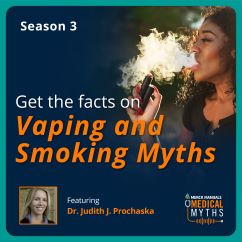- Drug Testing
- Vaping
- Injection Drug Use
- Body Packing and Body Stuffing
- Alcohol Toxicity and Withdrawal
- Alcohol Use Disorder and Rehabilitation
- Wernicke Encephalopathy
- Korsakoff Psychosis
- Marchiafava-Bignami Disease
- Amphetamines
- Methylenedioxymethamphetamine (MDMA)
- Anabolic Steroids
- Sedatives
- Cannabinoids, Synthetic
- Cathinones
- Cocaine
- Gamma Hydroxybutyrate
- Hallucinogens
- Ketamine and Phencyclidine (PCP)
- Marijuana (Cannabis)
- Opioid Toxicity and Withdrawal
- Opioid Use Disorder and Rehabilitation
- Other Commonly Abused Substances
- Volatile Nitrites
- Volatile Solvents
Vaping refers to the inhalation of volatilized liquid (vapor) produced by battery-powered devices. The vapor is primarily water, which is the vehicle for a variety of pharmacologically active substances, particularly nicotine and tetrahydrocannabinol (THC). Although the liquid ingredients are volatilized by heating, there is no combustion involved; the apparent "smoke" that results is water vapor.Vaping refers to the inhalation of volatilized liquid (vapor) produced by battery-powered devices. The vapor is primarily water, which is the vehicle for a variety of pharmacologically active substances, particularly nicotine and tetrahydrocannabinol (THC). Although the liquid ingredients are volatilized by heating, there is no combustion involved; the apparent "smoke" that results is water vapor.
Ingredients
In electronic cigarettes (e-cigarettes), the active substance is liquid nicotine; no other tobacco products are present. Electronic cigarettes and vaporizers were initially developed to help people quit smoking tobacco by providing a nicotine-delivery system in a form that mimics the oral and social gratifications of smoking but without the toxic products of combustion that are responsible for the adverse health effects of smoking tobacco. As smoking-cessation agents, e-cigarettes appear to be effective, although people remain addicted to nicotine (In electronic cigarettes (e-cigarettes), the active substance is liquid nicotine; no other tobacco products are present. Electronic cigarettes and vaporizers were initially developed to help people quit smoking tobacco by providing a nicotine-delivery system in a form that mimics the oral and social gratifications of smoking but without the toxic products of combustion that are responsible for the adverse health effects of smoking tobacco. As smoking-cessation agents, e-cigarettes appear to be effective, although people remain addicted to nicotine (1).
Some people use the vaporizers to inhale active ingredients other than nicotine, including tetrahydrocannabinol (THC), hashish oils, amphetamines, and synthetic cannabinoids. Some people use the vaporizers to inhale active ingredients other than nicotine, including tetrahydrocannabinol (THC), hashish oils, amphetamines, and synthetic cannabinoids.
In addition to water and the active ingredient, commercially produced vaping liquids usually contain propylene glycol or vegetable glycerin-based liquid along with flavoring and other chemicals, including trace amounts of metals. Illicitly produced vaping agents likely contain additional inactive ingredients, some of which, such as vitamin E acetate, may be involved in vaping-related pulmonary complications.In addition to water and the active ingredient, commercially produced vaping liquids usually contain propylene glycol or vegetable glycerin-based liquid along with flavoring and other chemicals, including trace amounts of metals. Illicitly produced vaping agents likely contain additional inactive ingredients, some of which, such as vitamin E acetate, may be involved in vaping-related pulmonary complications.
Complications of vaping
Potential complications include
Use of nicotine by nonsmokers, leading to nicotine addictionUse of nicotine by nonsmokers, leading to nicotine addiction
Pulmonary complications
One concern is that nonsmokers, particularly adolescents, who inhale nicotine, become addicted. One concern is that nonsmokers, particularly adolescents, who inhale nicotine, become addicted.
Certain substances in the vapor appear to lead to severe pulmonary injury. As of November 1, 2019, over 2000 cases of lung injury associated with e-cigarette or vapor use have been reported. The majority of reported cases are in young males who inhaled THC or cannabidiol-containing products. Chemicals and adulterants, particularly vitamin E acetate, are the most likely causative agents. Certain substances in the vapor appear to lead to severe pulmonary injury. As of November 1, 2019, over 2000 cases of lung injury associated with e-cigarette or vapor use have been reported. The majority of reported cases are in young males who inhaled THC or cannabidiol-containing products. Chemicals and adulterants, particularly vitamin E acetate, are the most likely causative agents.
Patients present with respiratory symptoms, gastrointestinal symptoms (pain), or other constitutional symptoms within 90 days after e-cigarette or vapor use. Subjective fever is the most common complaint. Patients may be tachycardic, tachypneic, or hypoxic. The condition may progress to acute respiratory distress syndrome.
The diagnosis is made by history of recent e-cigarette or vapor use and exclusion of other cause of lung injuries (eg, infection). Laboratory test may show leukocytosis with eosinophilia. Imaging studies of the lungs show bilateral lung opacities, most clearly seen with CT scan.
Treatment is supportive, and patients may require intubation, mechanical ventilation, and extracorporeal membrane oxygenation. Administration of high-dose glucocorticoids (eg, methylprednisolone 100 to 500 mg daily) has been suggested as beneficial, but evidence is sparse and it is not routinely recommended.Treatment is supportive, and patients may require intubation, mechanical ventilation, and extracorporeal membrane oxygenation. Administration of high-dose glucocorticoids (eg, methylprednisolone 100 to 500 mg daily) has been suggested as beneficial, but evidence is sparse and it is not routinely recommended.
Reference
1. Hajek P, Phillips-Waller A, Przulj D, et al: A randomized trial of e-cigarettes versus nicotine-replacement therapy.: A randomized trial of e-cigarettes versus nicotine-replacement therapy. N Engl J Med 380:629–637, 2019. doi: 10.1056/NEJMoa1808779

